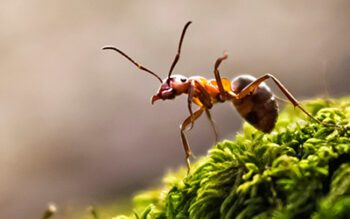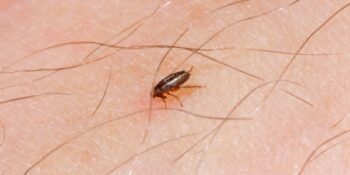
Spring and summer have come and gone, and we’re already heading into the winter holiday season, but it’s been an active few months for fleas this fall. Surprisingly, unlike many pests we deal with, fleas aren’t ready to make their exit when the temperatures start to drop, and it’s quite common to see significant flea activity during the fall, which is why protecting your family and pets year-round is an absolute must for Long Island homeowners.
Fall Fleas…What’s the Deal? 
It’s a common misconception that summer is the worst time of year for dealing with flea infestations, and insects like fleas “die off” once the temperatures drop. In actuality, flea season continues long past summer, and usually peaks from September to November.
As you’ve likely figured out, fleas thrive in the cooler temps of the fall season, and especially love a comfortable fall climate—in fact, optimum conditions for fleas to develop are a warm, moist environment around 70 degrees, with 70 to 85 percent humidity. It’s in these conditions that fleas can easily complete their life cycle, developing from egg to adult in a matter of weeks.
With female fleas laying roughly 40 eggs per day, as you can imagine, flea eggs can not only add up quickly, but infestations can seemingly pop up out of nowhere when flea eggs develop into larvae, pupae, and finally, adult fleas, who seek blood meals from hosts like you, your family, and your pets.
Where Do Fleas Come From?
Fleas can be somewhat of a mystery. One day, your house is seemingly pest-free*, and the next, you have a flea infestation. Outside, fleas will usually linger in grassy areas and wait for a host to pass by, such as your dog while you’re out for a quick walk. When opportunity strikes, fleas will latch onto the host and head toward areas that are harder to reach by claws or teeth, like the abdomen and under the legs. Then, fleas can freely hitchhike back indoors with you and your pup.
Let it be known that the family dog isn’t always to blame; pests like mice, rats, squirrels, and raccoons are also fair game hosts for fleas, so fleas can actually be just one part of a more complex set of pest issues in your home.
Signs of Fleas
If you have pets, they’re often the easiest way you’ll spot fleas in your house. Because adult fleas feed on the blood of their hosts (often cats and dogs) with their piercing-sucking mouthparts, flea bites on dogs and cats have indicators that these pests have made appearances. Fleas’ spit is actually what irritates animals, and will leave itchy red spots behind from where they drew blood. In addition to feeding on their hosts, fleas will also lay their eggs on their host animals and their bedding.
Preventing Fleas Before There’s a Problem
Because fleas are often introduced via rodents and other wildlife passerby, the most effective form of flea prevention is maintaining an annual pest management service. Our Total Protection Plans cover not only fleas, but rodents, as well. Total Protection customers also benefit from unlimited service calls—if a flea problem does pop up, just give us a call and we’ll come by at no extra charge! With regular preventive services and inspections by our licensed technicians, you’ll have a professional set of eyes on your house when we visit, as well as recommendations that can help prevent future issues.
Get complete peace of mind from pests like fleas year-round. For a free inspection of your home, call or text (631/516) 865-6900.





